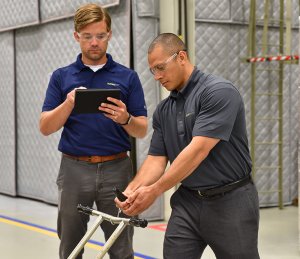The physical risk factors that have been consistently linked to the development of musculoskeletal disorders (MSDs) are posture, frequency, duration of exertion, and force. Recent research indicates that force has the greatest impact on MSD development. This can make it challenging to accurately quantify MSD risk, since force can be the most difficult risk factor to measure.
Most forces and loads that individuals interact with can be measured directly with a force gauge (push-pull meter) and a scale. For example, these tools can be used to measure the force required to pull a cart, push a part down a conveyor, and lift a product that is being transferred or palletized. However, these measurement tools are incapable of capturing the hand grip forces being exerted. Picture a situation where an operator grasps a tool to fasten screws and then grips a connector to perform an installation. Neither a force gauge nor a scale will be able to measure these forces and, instead, the force will have to be estimated or indirectly measured. This is where force matching becomes useful.
Force matching is a method that is widely used to measure forces. It relies on the individual reproducing the force immediately after performing a task and using this reproduction to determine the force required. Typically, a dynamometer is used to collect this information; two of the most common ones are hand- and pinch-grip dynamometers. Researchers have compared force match values to directly measured force values under a variety of conditions and have found a strong relationship between the two. This means that the force match method is a valid way to measure forces when it is executed properly. Below are the steps and guidelines to follow when using this methodology.
Steps
- Calibrate or “zero” the dynamometer readout. If using the hand dynamometer, adjust the grip span to match the width of the tool/part.
- Instruct the operator to pay close attention to how much force they are exerting during the task.
- Immediately after the task is performed, instruct the operator to reproduce the force on the dynamometer to match the exertion to the best of their ability.
- Record the measured force.
- Repeat steps 2 through 4 at least another four times and use the average of the recorded force measurements.
Guidelines
- Support the weight of the dynamometer when the individual is performing the force matching.
- The individual should use the same arm posture when replicating the force as was used when performing the task. Pay close attention to the shoulder, elbow, and wrist postures during the task to ensure they are the same when force matching.
- Collect 5 to 10 force measurements per task.
- Ideally, collect force measurements from two operators who perform the task regularly.
Do not include any force measurements that are significantly higher or lower than the others when calculating the average force. A good rule of thumb is to exclude values that are outside a 20-lb and 10-lb range for the hand- and pinch-grip dynamometer measurements, respectively. For example, you measured the following forces using the hand dynamometer: 15 lb, 23 lb, 45 lb, 20 lb, 25 lb. Most values are within a 20-lb range of 15 lb to 35 lb. Therefore, you would exclude the 45-lb measurement, as it lies outside this range.
Keep in mind that the force matching method is based on an individual’s perception of the force being exerted and is therefore a subjective measurement, which can result in inaccurate force estimates. However, by following the steps and guidelines above, you will minimize any individual biases.
References: Bao, S., Silverstein, B. (2005). Estimation of hand force in ergonomic job evaluations. Ergonomics 48, 288 – 301; Bao, S., Spielholz, P., Howard, N., Silverstein, B. (2009); Force measurement in field ergonomics research and application. International Journal of Industrial Ergonomics 39, 333 – 340; Dale, A.M., Rohn, A.E., Patton, A., Standeven, J., Evanoff, B. (2011). Variability and misclassification of worker estimated hand force. Applied Ergonomics 42, 846 – 851; Koppelaar, E.,Wells, R. (2005). Comparison of measurement methods for quantifying hand force. Ergonomics 48, 983 – 1007.
